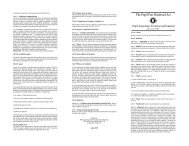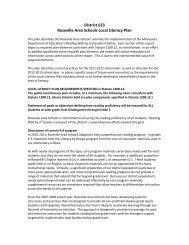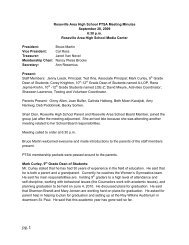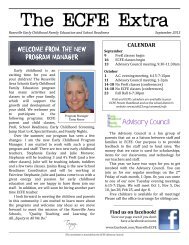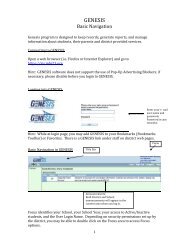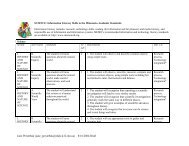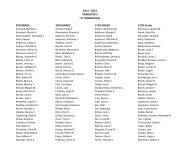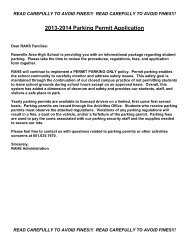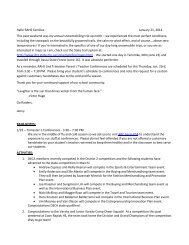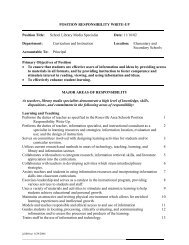Annual Report on Student Achievement - Roseville Area Schools
Annual Report on Student Achievement - Roseville Area Schools
Annual Report on Student Achievement - Roseville Area Schools
You also want an ePaper? Increase the reach of your titles
YUMPU automatically turns print PDFs into web optimized ePapers that Google loves.
DISTRICT 623 • ANNUAL REPORT ON CURRICULUM, INSTRUCTION, AND STUDENT ACHIEVEMENT • 2013<br />
A letter from the Superintendent<br />
October 2013<br />
Dear Friends:<br />
At the start of each school year, the staff of<br />
<strong>Roseville</strong> <strong>Area</strong> <strong>Schools</strong> spends workshop time<br />
planning for the arrival of the students and their<br />
families. The main focus of staff planning is to<br />
ensure that each and every student is well<br />
prepared for the upcoming school year and<br />
bey<strong>on</strong>d.<br />
“Educati<strong>on</strong> is the passport to the future, for<br />
tomorrow bel<strong>on</strong>gs to those who prepare for<br />
it today.” — MALCOLM X<br />
• Advancement Via Individual Determinati<strong>on</strong><br />
(AVID). The AVID program is a structured<br />
program designed to improve academic<br />
performance and provide direct support to<br />
students who are typically underserved.<br />
The students arrive at the school doors with unlimited<br />
potential and a w<strong>on</strong>derful array of talents.<br />
<strong>Roseville</strong> <strong>Area</strong> <strong>Schools</strong> embraces its resp<strong>on</strong>sibility<br />
to prepare each learner of today and shape their<br />
talents to meet the opportunities of tomorrow.<br />
During the school year, the staff reviews the<br />
performance of our students and looks for new<br />
and better ways of preparing each and every<br />
learner for the next phase of their academic career.<br />
After reviewing the data in our <str<strong>on</strong>g>Annual</str<strong>on</strong>g> <str<strong>on</strong>g>Report</str<strong>on</strong>g> <strong>on</strong><br />
Curriculum Instructi<strong>on</strong> and <strong>Student</strong> <strong>Achievement</strong><br />
and the academic success stories below, it will be<br />
clear to you that <strong>Roseville</strong> <strong>Schools</strong> provides a<br />
number of methods and tools that allow students<br />
to explore new and exciting learning opportunities<br />
that will better enable our students to be prepared<br />
for tomorrow.<br />
INSIDE<br />
District Goals. . . . . . . . . . . . . . . . . . . . . 2<br />
Performance Highlights . . . . . . . . . . . . 3<br />
Graduati<strong>on</strong> Tests . . . . . . . . . . . . . . . . . 7<br />
2010-11 Test Schedule . . . . . . . . . . . . . 7<br />
Building <str<strong>on</strong>g>Report</str<strong>on</strong>g>s . . . . . . . . . . . . . . . . . . 8<br />
• Reading Recovery Program. This program is<br />
designed to provide intense, individual interventi<strong>on</strong><br />
for first graders who are experiencing difficulties<br />
learning to read and write.<br />
• iPad Initiative. This program is a pilot initiative<br />
in progress at <strong>Roseville</strong> <strong>Area</strong> Middle School. The<br />
goals of the pilot are to increase student<br />
achievement and staff instructi<strong>on</strong>al skills.<br />
• Sec<strong>on</strong>d Steps Program. This program for middle<br />
school students focuses <strong>on</strong> bullying, substance<br />
abuse, and violence preventi<strong>on</strong> at this important<br />
time in our students’ lives.<br />
• Sheltered C<strong>on</strong>tent. This program delivers core<br />
academic instructi<strong>on</strong> to our high school English<br />
Language Learners.<br />
Thank you for supporting <strong>Roseville</strong> <strong>Area</strong> <strong>Schools</strong><br />
and allowing us the opportunity to work with the<br />
most important people in the world….your<br />
children.<br />
.<br />
Sincerely,<br />
Dr. John Thein<br />
Superintendent<br />
<str<strong>on</strong>g>Annual</str<strong>on</strong>g> <str<strong>on</strong>g>Report</str<strong>on</strong>g> <strong>on</strong> Curriculum, Instructi<strong>on</strong>, and <strong>Student</strong> <strong>Achievement</strong> 1 <strong>Roseville</strong> <strong>Area</strong> <strong>Schools</strong> • 2013
<strong>Roseville</strong> <strong>Area</strong> <strong>Schools</strong><br />
Missi<strong>on</strong> Statement–Our Core Purpose<br />
Quality Teaching and Learning for All...Equity in All We Do<br />
OUR VISION 2015<br />
What we intend to create<br />
<strong>Roseville</strong> <strong>Area</strong> <strong>Schools</strong>, working in partnership<br />
with all families and the community, is a learning<br />
organizati<strong>on</strong> of engaged, motivated and high<br />
achieving lifel<strong>on</strong>g learners.<br />
We dem<strong>on</strong>strate this Visi<strong>on</strong> when:<br />
Each learner thrives in a safe, equitable, and<br />
respectful learning envir<strong>on</strong>ment that fosters<br />
c<strong>on</strong>fidence, excellence and a sense of bel<strong>on</strong>ging<br />
while h<strong>on</strong>oring difference.<br />
Each learner receives high quality, pers<strong>on</strong>ally<br />
relevant instructi<strong>on</strong> enhanced by all members of<br />
the learning community.<br />
Each learner studies a challenging academic<br />
curriculum, which enhances social, emoti<strong>on</strong>al,<br />
physical and ethical development.<br />
Each learner meets rigorous academic standards<br />
and is prepared for future learning and success<br />
in a multicultural society.<br />
CORE VALUES<br />
What drives our words and acti<strong>on</strong>s<br />
Equity<br />
Resp<strong>on</strong>sibility<br />
Integrity<br />
Respect<br />
Compassi<strong>on</strong><br />
Commitment<br />
Sense of Bel<strong>on</strong>ging<br />
Curiosity<br />
EQUITY VISION<br />
In alignment with the District Visi<strong>on</strong>, <strong>Roseville</strong> <strong>Area</strong><br />
<strong>Schools</strong> is committed to ensuring an equitable and<br />
respectful educati<strong>on</strong>al experience for every student,<br />
family and staff member regardless of:<br />
Race<br />
Gender<br />
Sexual Orientati<strong>on</strong><br />
Socioec<strong>on</strong>omic Status<br />
Ability<br />
Home or First Language<br />
Religi<strong>on</strong><br />
Nati<strong>on</strong>al Origin<br />
Age<br />
Physical Appearance<br />
STRATEGIC DIRECTIONS<br />
Our focused allocati<strong>on</strong> of resources<br />
C<br />
L<br />
E<br />
AR<br />
<strong>Achievement</strong> Aligning systems, practices, and<br />
instructi<strong>on</strong> to the individual’s<br />
needs, abilities and goals.<br />
Community Engaging and partnering with the<br />
whole community.<br />
Leadership Building a culture that nurtures<br />
the leadership potential in each<br />
member of the diverse learning<br />
community.<br />
Equity Ensuring each individual develops<br />
and thrives; eliminating systemic<br />
barriers to success.<br />
Resources Securing, managing and leveraging<br />
our human, financial, and physical<br />
capital resp<strong>on</strong>sibly and creatively.<br />
<str<strong>on</strong>g>Annual</str<strong>on</strong>g> <str<strong>on</strong>g>Report</str<strong>on</strong>g> <strong>on</strong> Curriculum, Instructi<strong>on</strong>, and <strong>Student</strong> <strong>Achievement</strong> 2 <strong>Roseville</strong> <strong>Area</strong> <strong>Schools</strong> • 2013
Performance highlights<br />
Every year, leadership teams in each<br />
school in the district engage in the<br />
process of creating a school improvement<br />
plan and setting goals that are<br />
anchored in the Equity and<br />
<strong>Achievement</strong> Visi<strong>on</strong>Cards. During this<br />
process the team looks back at their<br />
data from the previous school year<br />
and evaluates their performance<br />
looking for areas of success and areas<br />
for improvement. The school teams<br />
develop detailed acti<strong>on</strong> steps they will<br />
follow in efforts to meet their goals,<br />
an assessment plan to measure<br />
progress, and the professi<strong>on</strong>al development<br />
that is needed to help achieve<br />
their goals.<br />
MAP Tests for 2012-13<br />
and Assessment Changes<br />
for 13-14<br />
The Measures of Academic Progress<br />
(MAP) tests provide teachers, students,<br />
and families with data used to set<br />
both individual and school goals. MAP<br />
is a set of computerized tests in<br />
reading and math which provide<br />
teachers accessible, informative, and<br />
instant results. The computerized<br />
system adjusts the difficulty level of<br />
questi<strong>on</strong>s based <strong>on</strong> the student’s<br />
pattern of correct/incorrect answers.<br />
<strong>Student</strong>s in grades 2-8 take the MAP<br />
at least twice (<strong>on</strong>ce in the Fall and<br />
again in the Spring). When students<br />
take the MAP in the Fall a target<br />
growth score for each student is set<br />
based <strong>on</strong> nati<strong>on</strong>al norms, and then<br />
the MAP is taken again in the Spring.<br />
The student’s scores from fall to<br />
spring are compared to provide the<br />
actual student growth to the target<br />
growth and staff are able to use these<br />
results immediately to inform their<br />
practice. The charts <strong>on</strong> page 4 show<br />
the average amount of growth made<br />
in RIT points, the scale used <strong>on</strong> the<br />
MAP. The blue bars indicate the<br />
average growth of <strong>Roseville</strong> students<br />
and the red squares indicate the<br />
nati<strong>on</strong>al average.<br />
District 623 MAP test summary:<br />
• Our district instructi<strong>on</strong>al and assessment<br />
focus in 2012-13 has been <strong>on</strong><br />
Test Primer<br />
Standardized tests are not the <strong>on</strong>ly method used to look at student progress.<br />
Teachers evaluate student achievement through a variety of other means throughout<br />
the year, and also c<strong>on</strong>sider the broad educati<strong>on</strong>al needs of children. However, standardized<br />
tests offer a measure for comparis<strong>on</strong> across district, state, and nati<strong>on</strong>al<br />
levels. Here is a brief primer about the standardized tests given in ISD 623.<br />
ACT/PLAN/EXPLORE: A series of nati<strong>on</strong>al tests that helps assess a student’s preparedness<br />
for college. <strong>Student</strong>s receive scores in English, Math, Reading and Science<br />
Reas<strong>on</strong>ing, as well as a composite score. In additi<strong>on</strong>, the PLAN test provides informati<strong>on</strong><br />
that helps improve a student’s career preparati<strong>on</strong>. The EXPLORE and PLAN are<br />
given to students in 8th and 10th grade. <strong>Student</strong>s self-select to take the ACT.<br />
Typically, about 70% of <strong>Roseville</strong> students choose to take the ACT.<br />
COGAT: Designed to measure students’ reas<strong>on</strong>ing abilities, the Cognitive Abilities Test<br />
(CogAT) is made up of three subtests: verbal, quantitative, and n<strong>on</strong>verbal (spatial). The<br />
test is administered to students in grade three and five in the Fall.<br />
MAP: A computerized adaptive assessment, Measures of Academic Progress (MAP)<br />
measures each student’s academic growth in reading, language use and mathematics.<br />
MAP tests align with state standards. Test results show a student’s strengths<br />
and weaknesses, allowing staff and parents to determine methods to help the student<br />
meet the projected growth for their age group.<br />
MCA-II/III: MCA is a statewide standardized achievement test that assesses student<br />
progress toward achieving Minnesota standards in reading, math and science. Test<br />
results are used to m<strong>on</strong>itor trends in student achievement.<br />
GRAD: Graduati<strong>on</strong> Required Assessments for Diploma (GRAD) measure whether<br />
students have mastered the skills in reading, math, and writing that are required to<br />
graduate by the State of Minnesota. <strong>Student</strong>s must achieve a passing score in all<br />
three subjects to be eligible for a public school diploma.<br />
ACCESS for ELL: Tests given to students with limited English proficiency, developed by<br />
the WIDA c<strong>on</strong>sortium are designed to dem<strong>on</strong>strate growth in English from year to<br />
year. ACCESS is a reading, writing, listening and speaking assessment.<br />
reading and math proficiency and<br />
state standards with less emphasis<br />
given to NWEA MAP tests. This<br />
impacted our MAP test growth<br />
scores by showing moderate<br />
decreases in students meeting their<br />
typical growth score while at the<br />
same time we saw moderate<br />
increases in MCA proficiency.<br />
• Although our growth scores<br />
declined we c<strong>on</strong>tinue to have high<br />
Spring Average RIT scores that are<br />
well above the nati<strong>on</strong>al average.<br />
• ISD 623 will c<strong>on</strong>tinue our instructi<strong>on</strong>al<br />
and assessment focus <strong>on</strong><br />
state standards and MCA proficiency<br />
as these are our state and federal<br />
accountability measures.<br />
For the 2013-14 school year,<br />
<strong>Roseville</strong> <strong>Area</strong> <strong>Schools</strong> has some<br />
exciting changes to our assessment<br />
plan. At our elementary schools we<br />
are focusing our efforts <strong>on</strong> increasing<br />
student instructi<strong>on</strong>al time and<br />
decreasing the time spent testing. We<br />
are doing this in c<strong>on</strong>juncti<strong>on</strong> with a<br />
new more efficient testing system<br />
called FAST. FAST stands for Formative<br />
Assessment System for Teachers and<br />
was developed by researchers at the<br />
University of Minnesota. This system<br />
includes a <strong>on</strong>e-<strong>on</strong>-<strong>on</strong>e screening for<br />
students in reading and whole group<br />
adaptive tests in both reading and<br />
math.<br />
<str<strong>on</strong>g>Annual</str<strong>on</strong>g> <str<strong>on</strong>g>Report</str<strong>on</strong>g> <strong>on</strong> Curriculum, Instructi<strong>on</strong>, and <strong>Student</strong> <strong>Achievement</strong> 3 <strong>Roseville</strong> <strong>Area</strong> <strong>Schools</strong> • 2013
<strong>Student</strong>s in K-6 will be screened this<br />
year by an assessment team made up<br />
of n<strong>on</strong>-classroom building staff<br />
members who will administer the<br />
reading screening three times during<br />
the year—September, December, and<br />
March. This informati<strong>on</strong> will then be<br />
used to provide reading instructi<strong>on</strong> to<br />
meet student needs and m<strong>on</strong>itor their<br />
progress throughout the year. The<br />
screening reduces the time that<br />
teachers have used at the beginning<br />
of the year individually administering<br />
reading tests to all students in their<br />
classrooms, thus increasing the time<br />
that the teacher has for instructi<strong>on</strong>.<br />
This fall students in grades 1-6 will<br />
also be taking adaptive tests in math<br />
(aMath) and reading (aReading). These<br />
tests are akin to the Measures of<br />
Academic Progress (MAP) tests that<br />
students in grades 2-8 have been<br />
taking for many years however, the<br />
aReading and aMath tests are much<br />
quicker in the time it takes for<br />
students to complete the test. The<br />
aReading and aMath tests, like MAP,<br />
adjust the level of difficulty based<br />
<strong>on</strong> how the student answers the<br />
questi<strong>on</strong>.<br />
<strong>Student</strong>s in grades K-2 will take the<br />
aMath and aReading tests again in the<br />
spring so that we can measure their<br />
growth over the school year. <strong>Student</strong>s<br />
in grades 3-6 will take the Minnesota<br />
Comprehensive Assessment (MCA) in<br />
<strong>Student</strong> Growth<br />
Measures of Academic Progress (MAP)<br />
Fall 2012 to Spring 2013<br />
ACT Results Over Time<br />
Average scale scores; based <strong>on</strong> scale of 36 points<br />
District 623<br />
% TAKING ENGLISH MATH READING SCIENCE COMPOSITE<br />
TEST<br />
REASONING<br />
2012-13 70% 22.8 22.8 23.3 23.1 23.1<br />
2011-12 70% 23.4 23.3 24.2 23.4 23.7<br />
2010-11 76% 23.3 23.7 23.6 23.3 23.6<br />
2009-10 73% 23.5 23.7 24.4 23.8 24.0<br />
2008-09 74% 23.4 23.7 24.6 23.9 24.0<br />
State<br />
2012-13 22.2 23.1 23.1 22.9 23.0<br />
2011-12 22.1 23.0 22.9 22.7 22.8<br />
2010-11 22.3 23.0 22.9 22.8 22.9<br />
2009-10 22.3 22.9 23.2 22.8 22.9<br />
2008-09 22.0 22.7 23.1 22.6 22.7<br />
Nati<strong>on</strong>al<br />
2012-13 20.2 20.9 21.1 20.7 20.9<br />
2011-12 20.5 21.1 21.3 20.9 21.1<br />
2010-11 20.6 21.1 21.3 20.9 21.1<br />
2009-10 20.5 21.0 21.3 20.9 21.0<br />
2008-09 20.6 21.0 21.4 20.9 21.1<br />
Math and Reading as their spring<br />
assessment.<br />
Some other changes to be aware of<br />
for 2013-14 are that students in<br />
Kindergarten will be tested using the<br />
FAST adaptive tests, however students<br />
in Kindergarten will not be testing<br />
until the winter testing window.<br />
<strong>Student</strong>s in 6th grade will c<strong>on</strong>tinue to<br />
take the MAP test for math as there is<br />
not an aMath test yet.<br />
ACT Test Results<br />
<strong>Roseville</strong> students c<strong>on</strong>tinued to<br />
perform well <strong>on</strong> the ACT. The ACT is<br />
used by many colleges as an entrance<br />
exam. The percentage of students<br />
Mathematics<br />
20<br />
Nati<strong>on</strong>al Average<br />
<strong>Roseville</strong> Average<br />
Reading<br />
20<br />
RIT GROWTH<br />
15<br />
10<br />
RIT GROWTH<br />
15<br />
10<br />
5<br />
5<br />
0<br />
2 3 4 5 6 7 8<br />
GRADE<br />
0<br />
2 3 4 5 6 7 8<br />
GRADE<br />
<str<strong>on</strong>g>Annual</str<strong>on</strong>g> <str<strong>on</strong>g>Report</str<strong>on</strong>g> <strong>on</strong> Curriculum, Instructi<strong>on</strong>, and <strong>Student</strong> <strong>Achievement</strong> 4 <strong>Roseville</strong> <strong>Area</strong> <strong>Schools</strong> • 2013
taking the ACT remained high in<br />
2012-13 with 70% of the graduating<br />
class participating in the exam. The<br />
test includes English, Mathematics,<br />
Reading and Science. <strong>Roseville</strong> <strong>Area</strong><br />
High School students remained above<br />
the state and nati<strong>on</strong>al scores in<br />
almost every category, a particularly<br />
outstanding result c<strong>on</strong>sidering the<br />
number of students that take the test.<br />
The composite score for <strong>Roseville</strong><br />
students was 23.1 compared to 23.0<br />
for Minnesota, and 20.9 nati<strong>on</strong>ally.<br />
District 623 MCA Results<br />
Percent of <strong>Student</strong>s Proficient in Reading<br />
GRADE LEVEL 3 4 5 6 7 8 10<br />
State 57.4 54.2 63.1 58.8 53.9 53.8 62.2<br />
District 55.0 50.8 59.8 62.9 51.4 50.8 67.1<br />
Percent of <strong>Student</strong>s Proficient in Math<br />
GRADE LEVEL 3 4 5 6 7 8 10<br />
State 71.5 71.3 59.1 55.9 54.3 57.3 51.5<br />
District 71.7 63.2 54.8 60.0 48.9 49.1 47.4<br />
MCA Tests<br />
Districts throughout the state<br />
administer the Minnesota<br />
Comprehensive Assessments (MCA)<br />
each year to measure student<br />
performance against state standards<br />
and to assess the yearly progress of<br />
schools in meeting the federal<br />
requirements of the No Child Left<br />
Behind legislati<strong>on</strong>. The MCAs are<br />
adjusted following the revisi<strong>on</strong> of the<br />
state’s standards in each discipline. In<br />
2012-2013, the reading test changed<br />
to a more difficult test that assesses<br />
more rigorous state standards. This<br />
test (MCA III) was administered to<br />
students in grades 3-8 and 10 in<br />
reading. <strong>Student</strong>s in grades 3-8<br />
c<strong>on</strong>tinued to take the <strong>on</strong>line MCA III<br />
math test, which was introduced in<br />
2010-11. <strong>Student</strong>s in grade 11 took the<br />
MCA II math test this year, however<br />
this test will change to the MCA III<br />
next year to align with state standards.<br />
The MCA III science test was<br />
administered to students in grades 5,<br />
8, and high school this year.<br />
District 623 MCA test summary:<br />
AYP GOALS MET/STUDENT GROUP<br />
<strong>Student</strong> Group Math Reading Attendance Graduati<strong>on</strong><br />
Participati<strong>on</strong>/Performance Participati<strong>on</strong>/Performance Rate<br />
All <strong>Student</strong>s (avg.) Yes No Yes Yes Yes No<br />
American Indian * Yes * Yes Yes *<br />
Asian/Pacific Isl Yes No Yes Yes Yes No<br />
Hispanic Yes Yes Yes Yes Yes *<br />
Black Yes Yes Yes Yes Yes No<br />
White Yes Yes Yes Yes Yes Yes<br />
LEP Yes No Yes No Yes No<br />
Free/Reduc Lunch Yes Yes Yes No Yes Yes<br />
Special Educati<strong>on</strong> Yes No Yes No Yes No<br />
*Not sufficient number of students to meet the cell size minimum<br />
• In reading, state and district proficiency<br />
rates decreased significantly,<br />
although, in almost all grade levels<br />
the state decreased more rapidly<br />
than <strong>Roseville</strong> which resulted in<br />
the district gaining <strong>on</strong> the state.<br />
Last year our district wide average<br />
for all grades combined was<br />
slightly below the state and now<br />
we are approximately even with<br />
the state average.<br />
• In math, we increased moderately<br />
while the state dropped moderately<br />
(except in 11th grade where the<br />
state increased significantly and we<br />
increased moderately). Our trend<br />
of slight to moderate losses while<br />
the state gained in 2011-2012 has<br />
Reading<br />
Relative Proficiency Gains/Losses to State from 2011-12 to 2012-13<br />
Math<br />
Relative Proficiency Gains/Losses to State from 2011-12 to 2012-13<br />
<str<strong>on</strong>g>Annual</str<strong>on</strong>g> <str<strong>on</strong>g>Report</str<strong>on</strong>g> <strong>on</strong> Curriculum, Instructi<strong>on</strong>, and <strong>Student</strong> <strong>Achievement</strong> 5 <strong>Roseville</strong> <strong>Area</strong> <strong>Schools</strong> • 2013
turned around, although we still<br />
need a moderate increase in most<br />
grades (except grade 6) to catch up<br />
to the state.<br />
• On all of the state tests, the<br />
percentage of students achieving<br />
the highest level of performance<br />
remains (with a couple excepti<strong>on</strong>s)<br />
at or above state averages.<br />
MMR and AYP<br />
The Federal No Child Left Behind<br />
(NCLB) Act requires that all schools in<br />
the nati<strong>on</strong> make Adequate Yearly<br />
Progress (AYP) toward achieving the<br />
goal of all students being proficient in<br />
reading and math by 2014. In 2012<br />
Minnesota was granted a Waiver from<br />
the NCLB law. With the Waiver, the<br />
Minnesota Department of Educati<strong>on</strong><br />
has set new accountability targets that<br />
focus <strong>on</strong> closing the achievement<br />
gaps by 50 percent over the next six<br />
years. Al<strong>on</strong>g with these targets the<br />
state created measures that m<strong>on</strong>itor<br />
the progress in closing those gaps.<br />
This measurement system called the<br />
Multiple Measurement Rating (MMR)<br />
was introduced in 2011-12 school<br />
year. The MMR is being used to gauge<br />
performance in four areas including:<br />
1. Proficiency—did the school meet<br />
its performance goals?<br />
2. Growth—are students making<br />
expected progress?<br />
3. <strong>Achievement</strong> Gap Reducti<strong>on</strong>—did<br />
the school make progress closing<br />
its overall achievement gaps?<br />
4. Graduati<strong>on</strong> Rate (where applicable)—did<br />
the school meet its<br />
graduati<strong>on</strong> rate targets?<br />
<strong>Schools</strong> can achieve up to 25 points<br />
in each area (where applicable) based<br />
<strong>on</strong> their percentile rank for that area.<br />
The overall MMR score is a<br />
percentage of the total points earned<br />
out of the total points possible.<br />
<strong>Schools</strong> and districts will no l<strong>on</strong>ger<br />
be labeled as failing or not failing,<br />
new designati<strong>on</strong>s for Title I schools<br />
have been created which include:<br />
• Reward <strong>Schools</strong>—The 15 percent<br />
of highest-performing Title I<br />
schools in the state.<br />
• Celebrati<strong>on</strong> <strong>Schools</strong>—Eligible<br />
schools are in the Top 25% of Title<br />
I schools that have not been designated<br />
as a Reward School.<br />
• C<strong>on</strong>tinuous Improvement<br />
<strong>Schools</strong>—The bottom 25% of Title<br />
I schools not identified as Priority<br />
or Focus <strong>Schools</strong>.<br />
DCAC<br />
The District Curriculum Advisory<br />
Committee (DCAC) plays an important role<br />
in improving student achievement. The<br />
DCAC advises the School Board and<br />
district administrators, ensuring active<br />
community participati<strong>on</strong> in planning and<br />
improving instructi<strong>on</strong> and curriculum.<br />
The DCAC reviews reports of curriculum<br />
study committees, results of student<br />
achievement tests, and other assessments<br />
of student learning. It also shares informati<strong>on</strong><br />
with the community about student<br />
performance goals, test results, district<br />
improvement plans, and progress <strong>on</strong><br />
previous improvement plans.<br />
The committee includes parent representatives<br />
and district staff members. The<br />
principal and parent groups help to recruit<br />
a representative. Thank you to current<br />
council members.<br />
Parent Representatives BUILDING TERM ENDS<br />
Mary Bachhuber Brimhall Elementary 2014<br />
Philip Belin Little Canada Elementary 2015<br />
Nancy Brown Emmet D. Williams Elementary 2016<br />
Joe Brown Thunder Falc<strong>on</strong> Heights Elementary 2013<br />
Erin Cr<strong>on</strong>in Edgert<strong>on</strong> Elementary 2013<br />
Shana Cross<strong>on</strong> <strong>Roseville</strong> <strong>Area</strong> High School 2014<br />
Maria MacWilliams <strong>Roseville</strong> <strong>Area</strong> High School 2014<br />
Mimi W<strong>on</strong>g Parkview Center School 2014<br />
Brad Zenner Parkview Center School 2015<br />
<strong>Student</strong> Representative<br />
Katherine Allen <strong>Roseville</strong> <strong>Area</strong> High School 2013<br />
M<strong>on</strong>ica Basabe <strong>Roseville</strong> <strong>Area</strong> High School 2014<br />
Chang Xi<strong>on</strong>g <strong>Roseville</strong> <strong>Area</strong> High School 2014<br />
Staff Representatives<br />
Erin Azer School Board 2013<br />
Becky Berkas Edgert<strong>on</strong> Elementary 2013<br />
Jennifer Kohan Fairview Alt. High School 2015<br />
Todd Lieser <strong>Roseville</strong> <strong>Area</strong> High School 2014<br />
Kristen Smith Ols<strong>on</strong> Parkview Center School 2013<br />
Jake V<strong>on</strong> De Linde Department of Teaching & Learning —<br />
Membership Criteria:<br />
Each K-6 building in the District has <strong>on</strong>e representative to the DCAC; Parkview, <strong>Roseville</strong> <strong>Area</strong> Middle School, and the High School,<br />
each have two seats <strong>on</strong> the DCAC. Building representatives serve 3-year terms. Staff members represent various comp<strong>on</strong>ents of<br />
the District, both programs and sites. Compositi<strong>on</strong> of the DCAC voting membership is 75% citizens and 25% staff. Citizens interested<br />
in serving should c<strong>on</strong>tact their building principal or Jake V<strong>on</strong> De Linde.<br />
Applicati<strong>on</strong> Date:<br />
The first meeting is typically mid-late September; the goal is to have established membership before that first meeting. If membership<br />
is not complete by the first meeting, District staff will c<strong>on</strong>tinue to seek the full slate of members until the roster is filled.<br />
<str<strong>on</strong>g>Annual</str<strong>on</strong>g> <str<strong>on</strong>g>Report</str<strong>on</strong>g> <strong>on</strong> Curriculum, Instructi<strong>on</strong>, and <strong>Student</strong> <strong>Achievement</strong> 6 <strong>Roseville</strong> <strong>Area</strong> <strong>Schools</strong> • 2013
• Focus <strong>Schools</strong>—The 10 Percent of<br />
Title 1 schools showing the largest<br />
achievement gaps in the state for<br />
<strong>on</strong>e or more groups of students.<br />
• Priority <strong>Schools</strong>—The bottom 5<br />
percent of Title I schools <strong>on</strong> the<br />
MMR.<br />
In <strong>Roseville</strong> we had 3 schools that<br />
had been given designati<strong>on</strong>s for the<br />
2012-13 school year. Central Park is a<br />
Focus School and is working with the<br />
District, The Regi<strong>on</strong>al Center of<br />
Excellence, and the Minnesota<br />
Department of Educati<strong>on</strong> (MDE), to<br />
m<strong>on</strong>itor and adjust their school<br />
improvement plan. Little Canada was<br />
identified last year a c<strong>on</strong>tinuous<br />
improvement school and worked with<br />
District staff to create a school<br />
improvement plan. Finally, Brimhall<br />
was a Celebrati<strong>on</strong> eligible school<br />
which means they were eligible to<br />
apply for the Celebrati<strong>on</strong> School<br />
designati<strong>on</strong>.<br />
MMR results will be released<br />
publicly by the Minnesota Depart -<br />
ment of Educati<strong>on</strong> <strong>on</strong> October 1st.<br />
Graduati<strong>on</strong> Tests<br />
All students graduating in <strong>Roseville</strong> <strong>Area</strong> <strong>Schools</strong> take the<br />
Graduati<strong>on</strong> Required Assessments for Diploma (GRAD)<br />
test. The writing test is taken for the first time in 9th grade, the<br />
reading test in 10th grade, and the mathematics test in 11th<br />
grade. The c<strong>on</strong>tent of the tests reflect the state’s graduati<strong>on</strong><br />
standards. <strong>Student</strong>s who did not pass have multiple opportunities<br />
to retake each test; however they must have a minimum of<br />
six weeks for remedial instructi<strong>on</strong> before their next test.<br />
<strong>Student</strong>s who do not pass the math GRAD are still eligible to<br />
receive a diploma if they have completed/passed all required<br />
coursework, have participated in prescribed remediati<strong>on</strong>, and<br />
have re-taken the GRAD math test at least twice. However<br />
legislati<strong>on</strong> was passed at the end of this year that changed<br />
graduati<strong>on</strong> requirements for students. The new legislati<strong>on</strong><br />
allows students who have taken a college or career readiness<br />
test (ACT, Compass, WorKeys, Accuplacer, or SAT) to graduate if<br />
they have also completed all of their required course credits.<br />
Because of these changes the writing test will be eliminated in<br />
2013-14 and there will also be no required remediati<strong>on</strong> for<br />
students who did not pass the GRAD. During the 2014-15<br />
school year the state will be phasing in a new College and<br />
Career Readiness test for grades 10 and 11.<br />
In 2012-13, passing rate after first test administrati<strong>on</strong><br />
included 85.1% of <strong>Roseville</strong> 9th grade students passing the<br />
GRAD writing test (compared to 87.8% state wide), and 64.4%<br />
of <strong>Roseville</strong> 11th grade students passing the GRAD math test<br />
(compared to 66.4% state wide). In reading this year the MCA<br />
III eliminated the GRAD embedded porti<strong>on</strong> of the test and<br />
making proficiency the new measure for meeting the GRAD<br />
standard. <strong>Student</strong>s in <strong>Roseville</strong> scored 67.1% proficient <strong>on</strong> the<br />
MCA III reading test compared to 62.2% state wide.<br />
Test Schedule for 2013–14<br />
ALTERNATIVE ASSESSMENTS<br />
Grade 3-11 MTAS Reading and Math March 17–May 9<br />
Grades 5, 8 and High School MTAS Science March 17–May 10<br />
NNAT<br />
Grades 3 & 5 October 21–25<br />
EL TESTS<br />
Grade K-12 ACCESS February 3–March 21<br />
MCA AND MCA MODIFIED<br />
MCA and MCA Modified Math & Reading Online<br />
Grade 3–8 March 31–May 1<br />
MCA Science Online<br />
Grade 5 & 8 May 5–9<br />
RAHS<br />
Grade 9-12 who have completed Biology by Tri 2 March 24–April 4<br />
Grade 9-12 who will complete Biology in Tri 3 May 12–May 16<br />
FAHS<br />
Grade 9-12 who have completed Biology May 12–May 16<br />
MCA/GRAD AND MCA MODIFIED<br />
Grade 10 Reading & Grade 11 Math Segments 1, & 2 April 15<br />
Grade 10 Reading & Grade 11 Math Segments 3, & 4 April 16<br />
NWEA MAP<br />
Grade 6 (Math)–8 and some HS September 16–October 4<br />
Spring MAP May 12–30<br />
FAST (K-6)<br />
Fall October 29–November 16, 2013<br />
Winter January 13–31<br />
Spring May 1–17<br />
OTHER TESTS<br />
Grade 8, EXPLORE, RAMS (AVID) November 19<br />
Grade 10, PLAN November 27<br />
Grade 11, PSAT October 16<br />
Grade 10–12, ACT Sept. 21, April 12, and June 14<br />
<str<strong>on</strong>g>Annual</str<strong>on</strong>g> <str<strong>on</strong>g>Report</str<strong>on</strong>g> <strong>on</strong> Curriculum, Instructi<strong>on</strong>, and <strong>Student</strong> <strong>Achievement</strong> 7 <strong>Roseville</strong> <strong>Area</strong> <strong>Schools</strong> • 2013
Moving Forward<br />
Brimhall<br />
Academic Goal: Our 2012-2013<br />
<strong>Achievement</strong> Goal indicated that we<br />
would work to increase our MCA proficiency<br />
rating in math from 68% to<br />
72.8%.<br />
Results indicated that we met and<br />
exceeded this target goal by obtaining<br />
a proficiency rating of 76.1%.<br />
Going into the 2012-2013 school year,<br />
our MCA math disparity for Hispanic<br />
students was 24%. Our 2012-2013 goal<br />
was to increase their proficiency by<br />
3.6% or more. As a result, the achievement<br />
gap in math would shrink to<br />
20.4%. The goal of our achievement gap<br />
should be a decrease of 3.6% or more.<br />
Results indicate that we increased<br />
proficiency by 6.4%. Thus, we<br />
exceeded our projected proficiency<br />
goal.<br />
Going into the 2012-2013 school year,<br />
our MCA math disparity for Black<br />
students was 34%. Our 2012-2013 goal<br />
was to increase their proficiency by<br />
5.1% or more. As a result, the achievement<br />
gap in math would shrink to<br />
28.9%. The goal of our achievement gap<br />
should be a decrease of 5.1% or more.<br />
Results indicate that our Black<br />
students increased proficiency by<br />
14.2%. Thus, we exceeded our<br />
projected proficiency goal.<br />
Equity Goal: Our current n<strong>on</strong>-duplicated<br />
referrals for Black students is 69%. In<br />
the 2012-2013 school year, n<strong>on</strong>-duplicated<br />
referrals for Black students will be<br />
reduced by 44%. The goal of n<strong>on</strong>-duplicated<br />
referrals for Black students will be<br />
25% or less.<br />
Results: At the end of 2012-2013, the<br />
results indicated that we reduced n<strong>on</strong>duplicated<br />
referrals for Black students<br />
to 39%.<br />
SWIS data indicated that 36.46% our<br />
African American students have been<br />
referred to the office <strong>on</strong>e or more times<br />
in 2011-2012, as compared to 25.23% of<br />
our White students. Our goal is to<br />
reduce our African American referrals to<br />
less than 25% in 2012-2013.<br />
Results: In 2012-2013, 28% of students<br />
who were sent to the office were<br />
African American.<br />
Central Park<br />
<strong>Achievement</strong> Goal: The percentage of<br />
all students enrolled October 1st in<br />
grades 3-6 at Central Park Elementary<br />
who earn achievement levels of Meets<br />
the Standards or Exceeds the Standards<br />
<strong>on</strong> the Math MCA III will increase from<br />
34.8% in 2012 to 37.8% in 2013.<br />
Results: 33.8% of Central Park<br />
students earned achievement levels of<br />
Meets the Standards or Exceeds the<br />
Standards <strong>on</strong> the Math MCA III; the<br />
goal was not met.<br />
Equity Goal: As of June 2013, Central<br />
Park will reduce by 30% the overrepresentati<strong>on</strong><br />
of Black/African American<br />
students in regards to office referrals<br />
relative to discipline (from 91% overrepresentati<strong>on</strong><br />
in 2011-2012 to 61% in<br />
2012-2013 and will reduce overrepresentati<strong>on</strong><br />
of Hispanic/Latino students by<br />
30% from 41.1% to 11.1%). This will<br />
place Central Park at Baseline and<br />
progressing, respectively, <strong>on</strong> the Visi<strong>on</strong><br />
Card. SWIS student informati<strong>on</strong> system<br />
will be used to collect data.<br />
Results: In June 2013, the goal of<br />
reducing overrepresentati<strong>on</strong> of<br />
Black/African American students in<br />
regards to office referrals relative to<br />
discipline was not met; the overrepresentati<strong>on</strong><br />
increased from 91% to<br />
131%. However, the goal of reducing<br />
overrepresentati<strong>on</strong> of Hispanic/Latino<br />
students in regards to office referrals<br />
relative to discipline was met; the overrepresentati<strong>on</strong><br />
decreased from 41.1%<br />
overrepresentati<strong>on</strong> to -8.0 underrepresentati<strong>on</strong><br />
placing CP at visi<strong>on</strong> for<br />
Hispanic/Latino students in this area.<br />
Edgert<strong>on</strong><br />
<strong>Achievement</strong> Goal: Edgert<strong>on</strong><br />
Elementary will improve proficiency in<br />
Math for all students grades 3-6 as<br />
measured by the MCA III from 48% to<br />
55% proficiency. (This is a 7% increase<br />
and will bring Edgert<strong>on</strong> from Level 1 to<br />
Level II <strong>on</strong> the RAS Visi<strong>on</strong> Card (A5).<br />
Results: Forty-seven percent of our<br />
students were proficient in Math as<br />
measured by the MCA III.<br />
Edgert<strong>on</strong> did not reach their goal<br />
target yet remain encouraged by the<br />
c<strong>on</strong>tinued progress students are<br />
showing in growth related to math.<br />
This is dem<strong>on</strong>strated by the number of<br />
students who grew from does not meet<br />
to partial proficiency. Recognizing the<br />
need to get students to proficiency <strong>on</strong><br />
state standards will be the focus of the<br />
work at Edgert<strong>on</strong> in the coming year.<br />
Teachers are aligning their instructi<strong>on</strong><br />
and assessment based <strong>on</strong> the state<br />
math standards. Our goals for 2013-<br />
2014 focus <strong>on</strong> student proficiency.<br />
Equity Goal: Currently Edgert<strong>on</strong> is a<br />
level 1(intervene) with a 39.7% disparity<br />
in reading. In 2012-2013 Edgert<strong>on</strong> will<br />
increase the achievement of all students<br />
and reduce the racial disparity to less<br />
than 14-19% difference (Baseline) as<br />
measured by the MCA in reading.<br />
Results: With the introducti<strong>on</strong> of new<br />
state reading standards and a subsequent<br />
new assessment, MCA III,<br />
Edgert<strong>on</strong> saw a drop in reading proficiency.<br />
This was comm<strong>on</strong> throughout<br />
the district and state. The racial<br />
disparity in reading did not change as<br />
we had expected. The difference<br />
between our students of color and our<br />
white students was 39.7%. Edgert<strong>on</strong><br />
did show str<strong>on</strong>g progress in the math<br />
achievement gap however. We will<br />
c<strong>on</strong>tinue to focus <strong>on</strong> meeting the individual<br />
learnin g needs of our students<br />
and we will reduce racial disparity it<br />
from 24.7 to 21%. For some student<br />
groups and will remain very focused<br />
<strong>on</strong> supporting the unique needs of EL<br />
students.<br />
<str<strong>on</strong>g>Annual</str<strong>on</strong>g> <str<strong>on</strong>g>Report</str<strong>on</strong>g> <strong>on</strong> Curriculum, Instructi<strong>on</strong>, and <strong>Student</strong> <strong>Achievement</strong> 8 <strong>Roseville</strong> <strong>Area</strong> <strong>Schools</strong> • 2013
Edgert<strong>on</strong> will c<strong>on</strong>tinue to address<br />
teaching and learning style differences<br />
of teachers and students and will work<br />
to reduce this disparity. Using a more<br />
standardized progress m<strong>on</strong>itor measure<br />
to predict proficiency will be an important<br />
tool for teachers as we work collaboratively<br />
to meet the needs of all<br />
students.<br />
Emmet D. Williams<br />
1. During the 2012/2013 school year the<br />
proficiency rate of 3-6 grade students<br />
will increase from 59.4 to 70% as<br />
evidenced by MCA test scores.<br />
Not Achieved. The students experienced<br />
a growth of 3.1% in Math<br />
performance to a level of 62.5%<br />
2. During the 2012/2013 school year the<br />
achievement gap between white and<br />
black students in the subject area of<br />
math will be reduced by 20% from<br />
51% to 31% as evidenced by student<br />
performance <strong>on</strong> the MCA III Math<br />
assessment in the spring of 2013.<br />
Not Achieved. The achievement gap<br />
was decreased by 3.6% to a level of<br />
47.4%<br />
3. During the 2012/2013 school year the<br />
achievement gap between white and<br />
hispanic students in the subject area<br />
of math will be reduced by 10% from<br />
29% to 19% as evidenced by student<br />
performance <strong>on</strong> the MCA III Math<br />
assessment in the spring of 2013.<br />
Not Achieved. The achievement gap<br />
actually increased to a level of 39.9%<br />
4. During the 2012/2013 school year the<br />
over-representati<strong>on</strong> of unduplicated<br />
Black student referrals will decrease<br />
by 68.8% from 138% to 69.2% as<br />
evidenced by referral reported in<br />
district Synerygy student management<br />
system.<br />
Not Achieved. The over-referral rate<br />
actually increased.<br />
5. During the 2012/2013 school year the<br />
over-representati<strong>on</strong> of unduplicated<br />
Hispanic student referrals will<br />
decrease by 34% from 67% to 33%<br />
as evidenced by referral reported in<br />
district Synerygy student management<br />
system.<br />
Achieved.<br />
Fairview Alternative<br />
Learning Center and High<br />
School<br />
<strong>Achievement</strong> Goal: The percentage of<br />
all students in grades 9-12 at the<br />
Fairview Alternative High School who<br />
take the NWEA MAP Reading test and<br />
score under 230 by October 17th and<br />
meet or exceed 150% of their fall to<br />
spring individual RIT growth projecti<strong>on</strong><br />
will increase from 47.0% in spring 2012<br />
to 60% in spring 2013.<br />
Results: 62% of FAHS students made<br />
150% growth in Reading <strong>on</strong> the NWEA<br />
MAP Test.<br />
<strong>Achievement</strong> Gap Reducti<strong>on</strong> Goal: By<br />
spring 2013, 30% of all students of color<br />
will be proficient <strong>on</strong> the MCA Reading<br />
test, which will be an increase of 10%<br />
from 2012 MCA results.<br />
Results: This goal was not achieved,<br />
partly due to a significant increase in<br />
the reading test’s rigor. We will carefully<br />
examine the new standards in<br />
order to improve performance in 2013-<br />
14.<br />
Equity Goal: In the spring of 2013, our<br />
school will focus <strong>on</strong> reducing the<br />
number of referrals of our black<br />
students from Level 1 Intervene to Level<br />
II High C<strong>on</strong>cern <strong>on</strong> the district’s E2:<br />
Visi<strong>on</strong> Card.<br />
Results: There was a reducti<strong>on</strong> of classroom<br />
referrals however, we are still at<br />
Level 1 Intervene.<br />
Falc<strong>on</strong> Heights<br />
<strong>Achievement</strong> Goal: Through the development<br />
and implementati<strong>on</strong> of systemic<br />
strategies, the percent of students in<br />
grades 3-6 who meet or exceed proficiency<br />
<strong>on</strong> their 2013 MCA math test will<br />
be at least 72%.<br />
Results: FHES students in grades 3-6<br />
2013 MCA math scores reflect proficiency<br />
of 78.9%. Reflecting 6.9% over<br />
the target goal.<br />
Equity Goal: The percentage of black<br />
and Hispanic students referred for discipline<br />
issues will decrease as compared<br />
to white students. The goal area will be<br />
measured by end of year discipline data.<br />
Results: We had been at Intervene and<br />
results show we c<strong>on</strong>tinue to be in<br />
Intervene cell for Black students.<br />
However, for our Hispanic students we<br />
have moved from Intervene to<br />
Progressing cell.<br />
Little Canada<br />
2012-2013 Site Overarching achievement<br />
goal-math: In the spring of 2013,<br />
the percentage of 3rd-6th grade students<br />
meeting or exceeding the state<br />
Mathematics performance standards will<br />
increase from 53% to 60 % as measured<br />
by the MCA III.<br />
Results: Little Canada met our achievement<br />
SMART goal in 2013 by achieving<br />
60.2% proficiency <strong>on</strong> the 2013 MCA III<br />
math test.<br />
2012-2013- Equity goal: By May 2013<br />
Little Canada will reduce the number of<br />
behavioral referrals for black students<br />
from 58% to 40%.<br />
Results: Little Canada did not meet it’s<br />
equity goal in 2013. Our data shows<br />
that we had 42% over representati<strong>on</strong><br />
of unduplicated office referrals and<br />
78% of duplicated office referrals for<br />
our black students. Both of these are at<br />
the visi<strong>on</strong> card level of intervene.<br />
However Little Canada Elementary<br />
School was at Level 5-Visi<strong>on</strong> for total<br />
proporti<strong>on</strong>ate distributi<strong>on</strong> of both<br />
duplicated and unduplicated office<br />
referrals for All <strong>Student</strong>s of Color,<br />
Hispanic students, and Asian <strong>Student</strong>s.<br />
Parkview Center School<br />
<strong>Achievement</strong> Goal: Within three years<br />
(2012 – 2015), 82% of all students will<br />
meet or exceed proficiency in math as<br />
measured by MCA III mathematics test,<br />
moving Parkview Center <strong>Schools</strong><br />
students from Level 03 Baseline to Level<br />
04 Progressing <strong>on</strong> our district Visi<strong>on</strong>Card<br />
metrics. In 2012 – 2013, Parkview<br />
Center School will maintain Level 03<br />
Baseline and increase the percent of<br />
students proficient <strong>on</strong> the MCA III mathematics<br />
test from 71.9% to at least<br />
75.7%.<br />
<str<strong>on</strong>g>Annual</str<strong>on</strong>g> <str<strong>on</strong>g>Report</str<strong>on</strong>g> <strong>on</strong> Curriculum, Instructi<strong>on</strong>, and <strong>Student</strong> <strong>Achievement</strong> 9 <strong>Roseville</strong> <strong>Area</strong> <strong>Schools</strong> • 2013
Results: In the spring of 2013 Parkview<br />
Center School students maintained<br />
level 03 Baseline and increased 3.8%<br />
from 71.9 to 75.7% of all students<br />
meeting or exceeding proficiency as<br />
measured by the MCA II.<br />
Parkview Center School met the 2012-<br />
2013 academic achievement goal.<br />
Gap Reducti<strong>on</strong> Goal: In 2012 – 2013,<br />
the difference across all student groups<br />
(achievement gap) <strong>on</strong> the MCA, Parkview<br />
Center School will maintain or improve<br />
Level 05 Visi<strong>on</strong> for all students of color<br />
in reading (8% disparity) and mathematics<br />
(8.7% disparity), although, we<br />
will intervene for our black students<br />
(who have at 34% disparity in reading<br />
and 32% disparity in mathematics)<br />
increase the MCA proficiency rate in<br />
reading from 56% to 62% and in mathematics<br />
from 42% to 50.7%.<br />
Results: In the spring of 2013 Parkview<br />
Center School increased math proficiency<br />
of our black students from 42%<br />
proficient to 53% proficient. The<br />
achievement gap between Black<br />
student and White students decreased<br />
from 32.3% to 21.6%. In reading, the<br />
achievement gap for black students<br />
when compared to white students was<br />
reduced from 34% to 32.1%. Parkview<br />
Center School did not meet the 2012-<br />
2013 equity goal. We did meet part of<br />
the goal reducing the achievement gap<br />
of black students when compared to<br />
white students in both math and<br />
reading. We also met our goal in math<br />
with a black students proficiency<br />
moving from 42% proficient to 53%<br />
proficient.<br />
Equity Goal: By June 2013, the overrepresentati<strong>on</strong><br />
of students of color will<br />
decrease from Level 02 high c<strong>on</strong>cern<br />
(21%) to Level 03 baseline (at most 19%)<br />
<strong>on</strong> our Visi<strong>on</strong>Card metrics as reported in<br />
the student informati<strong>on</strong> system<br />
(Synergy).<br />
Results: We increased our office<br />
referral for our black students from<br />
21% to 34%. Parkview Center School<br />
did not meet the 2012-2013 equity<br />
goal.<br />
<strong>Roseville</strong> <strong>Area</strong> Middle<br />
School<br />
ATPPS Goal: In spring of 2013, the<br />
percent of students in grades 7-8 at<br />
RAMS, who are proficient as measured<br />
by the MCA Math test will be at least 2<br />
percentage points higher than it was in<br />
the spring of 2012. (move from 47.8% to<br />
49.8%)<br />
RAMS did not reach the goal. Our<br />
proficiency rate was 46.2%.<br />
Overarching Goal: In spring of 2013, the<br />
percent of students in grade 7-8 at<br />
RAMS who are proficient as measured<br />
by the Math MCA test will be at least 7.8<br />
points higher than in spring 2012.<br />
(47.8% to 55.6% or a 14 % increase)<br />
RAMS did not reach the goal. Our<br />
proficiency rate was 46.2%.<br />
ATPPS <strong>Achievement</strong> Gap Reducti<strong>on</strong><br />
Goal: In 2012-2013 the disparity in the<br />
math MCA test for our Black and<br />
Hispanic students will decrease by 10%:<br />
from 41.0% to 36.9% for our Black<br />
students and 40.2% to 36% for our and<br />
Hispanic students.<br />
RAMS did reach the goal for our Black<br />
students. Our disparity rate for our<br />
Black students was 34.8%.<br />
RAMS did reach the goal for our<br />
Hispanic students. Our disparity rate<br />
for our Hispanic students was 30.4%.<br />
In 2012-13 the disparity in the reading<br />
MCA test for our Black and Hispanic will<br />
decrease by 10%: from 34.7% to 31.2%<br />
for our Black students and from 37.9%<br />
to 34.1% for our Hispanic students.<br />
RAMS did not reach the goal for our<br />
Black students. Our disparity rate for<br />
our Black students was 35.7%.<br />
RAMS did not reach the goal for our<br />
Hispanic students. Our disparity rate<br />
for our Hispanic students was 39.5%.<br />
Equity Goal: By June 2013, the<br />
percentage of overrepresentati<strong>on</strong> of<br />
Hispanic and Black students with regard<br />
to office referral will decrease by 10%<br />
from 63% and 117% respectively, to<br />
57% and 105% respectively.<br />
RAMS did not meet the goal for our<br />
Hispanic students. The goal was to go<br />
to 57% overrepresentati<strong>on</strong> and we<br />
went up to 85%.<br />
RAMS did meet the goal for the Black<br />
students. The goal was to go to 105%<br />
overrepresentati<strong>on</strong> and we went down<br />
to 95%.<br />
<strong>Roseville</strong> <strong>Area</strong> High School<br />
<strong>Achievement</strong> Goal: RAHS will increase<br />
MCA 10th Grade Reading Proficiency<br />
from 76% (2011-2012) to 79.6% (2012-<br />
2013).<br />
Results: With the implementati<strong>on</strong> of<br />
the new MCA III 10th grade Reading<br />
test, RAHS experienced a decline of<br />
6.9%. We were encouraged by outachieving<br />
the State (-14%).<br />
2012-2013 <strong>Achievement</strong> Gap Reducti<strong>on</strong><br />
Goal: RAHS will decrease the racial<br />
achievement disparity between our<br />
White <strong>Student</strong>s and <strong>Student</strong>s of Color<br />
from 29% to 24.7% as measured by<br />
MCA 10th Grade Reading Proficiency.<br />
Results: RAHS didn’t achieve our goal<br />
of narrowing the achievement gap.<br />
2012-2013 Equity Goal: RAHS will move<br />
from Level 1 to Level 2 <strong>on</strong> the District<br />
Visi<strong>on</strong>Card in relati<strong>on</strong>ship to Discipline<br />
Referrals and the Over-Representati<strong>on</strong> of<br />
<strong>Student</strong>s of Color.<br />
Results: RAHS didn’t achieve our goal<br />
of decreasing the over-representati<strong>on</strong><br />
of <strong>Student</strong>s of Color and discipline<br />
referrals.<br />
<str<strong>on</strong>g>Annual</str<strong>on</strong>g> <str<strong>on</strong>g>Report</str<strong>on</strong>g> <strong>on</strong> Curriculum, Instructi<strong>on</strong>, and <strong>Student</strong> <strong>Achievement</strong> 10 <strong>Roseville</strong> <strong>Area</strong> <strong>Schools</strong> • 2013




